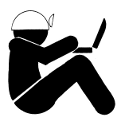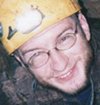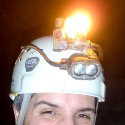Guesstimating L-R-C-F
Moderator: Moderators
56 posts
• Page 3 of 4 • 1, 2, 3, 4
latest post
For some reason, when I post here, page 2 shows up, but if I delete this post, page 2 disappears. Weird.
-

Wayne Harrison - NSS Hall Of Fame Poster
- Posts: 2382
- Joined: Aug 30, 2005 5:29 pm
- Location: Pine, Colorado
- NSS #: 18689 FE
- Primary Grotto Affiliation: unaffiliated
-

hewhocaves - NSS Hall Of Fame Poster
- Posts: 716
- Joined: Sep 5, 2005 9:43 pm
- Location: Morgantown WV
- Name: John Tudek
- NSS #: 36021
- Primary Grotto Affiliation: MonGrotto
Re: Whole passage LRUDs
cavedoc wrote:
Keith asked about the cylindrical passage. If your station is on a wall, then I think you still want Up and Down that will estimate the whole passage. This is for the volume and computer modeling reasons above, but also that having the very literal Up and Down of a few centimeters will not help the drafter in any way. If the drafter is going to ignore the information, or even worse, be misled by it, then why get it that way? If you really feel compelled, then use the "near/total" method that several folks have mentioned.
And I usually do my own LRUDs when I sketch.
Roger
Roger,
You betcha! The LR needs to be an estimate the WHOLE cross-sectional width of the passage and the UD need to show the entire cross-sectional height of the passage. Just saying that the right wall is two meters from the station horizontally is in no way sufficient to create a usable LRUD. While real-world examples are much more varied, a simple model for this is a perfectly diamond-shaped passage two meters wide with the station in the far left corner. Up is zero, down is zero, left is zero and right is 2m. Doesn't make for much of a cross section when recorded that way, eh?
As for doing your own LRUD, well yeah, that does get it right. My problem is that I'd much rather be sketching with an LRUD under my criteria called out by someone down the survey. If I don't have an LRUD until I actually arrive at the "to" station, I'm already behind in my sketch.
Keith
-

tropicalbats - Prolific Poster
- Posts: 104
- Joined: Sep 5, 2005 12:18 am
- Location: Falls Church, VA
The "standard" method of dimensioning a passage is from the station to the wall (or ceiling or floor). So if you are using total passage width or height in the notes, you should indicate that fact REAL prominently at the beginning of the survey. And maybe tell the cartographer what you have done. I know, from experience, that it is NO fun to figure out this little tidbit of information after you are finished drawing the working map.
When surveying, I'll often take a last shot down a passage that ends (or gets to tight or narrow). In those cases I just use total passage height and width. But it is always marked in the notes (either with a "w" or "h" for wide and high), and I only have one dimension number where I would usually have two.
xxxxxxxxxxxxx
I too will put more then one number in a dimenion box.
For example: 0/2/6 4 3 2
This means there were "three" left walls, such as with an alcove. I also dimension a lot of things, with alcoves being the prime item. That way I know how wide and high they are.
A ceiling crack would be "0/2" if the station has been placed on the "main" ceiling.
xxxxxxxxxxxxx
I usually sketch from the front, so the left and right dimensions have to be "turned around" before I write them down. Usually I get this right...
There is nothing "clean" about my sketches.
When surveying, I'll often take a last shot down a passage that ends (or gets to tight or narrow). In those cases I just use total passage height and width. But it is always marked in the notes (either with a "w" or "h" for wide and high), and I only have one dimension number where I would usually have two.
xxxxxxxxxxxxx
I too will put more then one number in a dimenion box.
For example: 0/2/6 4 3 2
This means there were "three" left walls, such as with an alcove. I also dimension a lot of things, with alcoves being the prime item. That way I know how wide and high they are.
A ceiling crack would be "0/2" if the station has been placed on the "main" ceiling.
xxxxxxxxxxxxx
I usually sketch from the front, so the left and right dimensions have to be "turned around" before I write them down. Usually I get this right...
There is nothing "clean" about my sketches.
-

George Dasher - NSS Hall Of Fame Poster
- Posts: 693
- Joined: Sep 22, 2005 2:00 pm
- Location: West Virginia
- NSS #: 16643
- Primary Grotto Affiliation: Charleston Grotto
George,
The "standard" method? One person's standard is another's oddball approach.
Our "standard" in Kentucky is full passage dimensions at the station, not just the distance to the wall or ceiling at that "point".
What is a challenge in Mammoth is the dimensions that say, for example, "4/6". Our "standard" is that these are to major "inflection points" in the cross section -- e.g., distance to a ledge/wall, water surface/floor, main ceiling/canyon-in-ceiling height. The problem is knowing if these numbers are to be added, or if they are discrete. In the example, "4/6", I have seen this to mean the passage is 10 feet wide, as well as 6 feet wide. I usually can figure it out, but I have to be careful.
For drawing the map, the entire cross-section dimensions are necessary. For refinding the station, information relative to the point itself can be useful (the fact that it is on the "wall", even though the wall -- full cross-section -- is different.
The "standard" method? One person's standard is another's oddball approach.
Our "standard" in Kentucky is full passage dimensions at the station, not just the distance to the wall or ceiling at that "point".
What is a challenge in Mammoth is the dimensions that say, for example, "4/6". Our "standard" is that these are to major "inflection points" in the cross section -- e.g., distance to a ledge/wall, water surface/floor, main ceiling/canyon-in-ceiling height. The problem is knowing if these numbers are to be added, or if they are discrete. In the example, "4/6", I have seen this to mean the passage is 10 feet wide, as well as 6 feet wide. I usually can figure it out, but I have to be careful.
For drawing the map, the entire cross-section dimensions are necessary. For refinding the station, information relative to the point itself can be useful (the fact that it is on the "wall", even though the wall -- full cross-section -- is different.
Roppel Caver guy
- Roppelcaver
- Prolific Poster
- Posts: 158
- Joined: Sep 4, 2005 11:23 pm
Dwight asked:
"And who uses the LRUD, aside from those funky looking maps generated by Compass, etc.?"
They're used in the fractal analysis of cave geometry. See
R.L. Curl, 1986, Fractal dimensions and geometries of caves: Math. Geol., vol. 18, no. 2, p. 765-783.
"And who uses the LRUD, aside from those funky looking maps generated by Compass, etc.?"
They're used in the fractal analysis of cave geometry. See
R.L. Curl, 1986, Fractal dimensions and geometries of caves: Math. Geol., vol. 18, no. 2, p. 765-783.
- Rane Curl
- Infrequent Poster
- Posts: 11
- Joined: Jan 25, 2006 2:44 pm
- Location: Ann Arbor, MI
Ralph E. Powers wrote:Thanks for the replies...
One thing of (minor) interest not that it makes tooo big of a difference is how it would seem the cavers from the east use Left Right UP DOWN whereas I was taught to survey (here in the west) Left Right CEILING FLOOR. I've heard a surveying using the UP DOWN and thought nothing of it but most commonly hear Ceiling Floor. ....
Just find it an interesting demographic ( I think).
So do you call them LRCF? All the premade sheets I've seen here always say LRUD- but then they are all products of eastern cavers.
-

rchrds - Prolific Poster
- Posts: 197
- Joined: Sep 6, 2005 8:54 pm
- Location: Fayetteville, NC
- Name: Jason Richards
- NSS #: 41539
- Primary Grotto Affiliation: None at the moment
That's why one needs to sketch to scale, and if can, on a clipboard. That's why you have people on tape, to tape everything you need for your sketch, that rock over there, that crack, formation, path, what ever. As for LRUD, all the puter programs I know only want one distance for each, not two or more. Again that's what a good sketch is for to tell/show you where everything is located in the passage. Also those who put down a P for L or R walls, draw an imaginary line across the passage and give me that distance, the sketch will show that there is a passage there, or at least take one shot down it. My son still complains  about having to tape every turn of the commerical path in Gap Cave (Cudjo's) in Va. Which has now passed the 8 mile mark
about having to tape every turn of the commerical path in Gap Cave (Cudjo's) in Va. Which has now passed the 8 mile mark 
 about having to tape every turn of the commerical path in Gap Cave (Cudjo's) in Va. Which has now passed the 8 mile mark
about having to tape every turn of the commerical path in Gap Cave (Cudjo's) in Va. Which has now passed the 8 mile mark -

caverbob - Occasional Poster
- Posts: 26
- Joined: Sep 4, 2005 11:55 pm
- Location: Odenton, Maryland
Re:
Ralph E. Powers wrote:One thing of (minor) interest not that it makes tooo big of a difference is how it would seem the cavers from the east use Left Right UP DOWN whereas I was taught to survey (here in the west) Left Right CEILING FLOOR. I've heard a surveying using the UP DOWN and thought nothing of it but most commonly hear Ceiling Floor. ....
Think of all the syllables you could save by shouting "Give me the damned el-ruds!"
-

driggs - NSS Hall Of Fame Poster
- Posts: 495
- Joined: Sep 12, 2005 9:40 pm
- Location: State of Jefferson
- Name: David A. Riggs
- NSS #: 56189
- Primary Grotto Affiliation: Monongahela
Re: Guesstimating L-R-C-F
I grew tired of lead tape people giving me, er... "questionable" LRUDs, so I save all my syllables and do them myself while sketching. Why draw your passage walls to your lead tape guy's estimate when you can draw them to your own estimate? Or, even better, your own actual measurement with a laser rangefinder?
"Although it pains me to say it, in this case Jeff is right. Plan accordingly." --Andy Armstrong
-

Jeff Bartlett - NSS Hall Of Fame Poster
- Posts: 948
- Joined: Jun 29, 2007 12:19 am
- Location: Chattanooga, TN
- Name: Jeff Bartlett
- NSS #: 59325
- Primary Grotto Affiliation: Tennessee Cave Survey
Re: Guesstimating L-R-C-F
Taping LRUDS is counterproductive in small passage. If I estimate the ceiling height at 3 feet when in fact it is about 1.5 feet then I can, with a clear conscience, say I didn't lie when I sucker...err...invite new survey crew members 

I'm not scared of the dark, it's the things IN the dark that make me nervous. :)
-

wyandottecaver - NSS Hall Of Fame Poster
- Posts: 2902
- Joined: Aug 24, 2007 8:44 pm
- Location: Indiana
Re: Guesstimating L-R-C-F
I do lots of sketching in the Western United States and use LRUD. I have heard of UDLR, but never LRCF.
Does everyone record LRUD looking toward the next station, or does anyone use direction of last shot? I used to do it the latter way until I realized that almost everyone else does it the former way. I changed my ways several years ago so as not to confuse cartographers or anyone else. So I have conformed, but still find the toward next station way to be problematic at junctions and ends of passages.
I often have the instrument person feed me LRUD's. (A really good instrument person can be trained to do this by habit right after the shot , without even having to be asked!) But I confess, I always feel like the LRUD's I record myself are more accurate.
While I sympathize with cold surveyors (I am often one of them), I do not feel it is acceptable to sacrifice survey quality because of coldness or expedition booty fever. If you do, you force other people to come back later and fix your crappy survey! I have spent a good part of my caving career doing just that!
Does everyone record LRUD looking toward the next station, or does anyone use direction of last shot? I used to do it the latter way until I realized that almost everyone else does it the former way. I changed my ways several years ago so as not to confuse cartographers or anyone else. So I have conformed, but still find the toward next station way to be problematic at junctions and ends of passages.
I often have the instrument person feed me LRUD's. (A really good instrument person can be trained to do this by habit right after the shot , without even having to be asked!) But I confess, I always feel like the LRUD's I record myself are more accurate.
While I sympathize with cold surveyors (I am often one of them), I do not feel it is acceptable to sacrifice survey quality because of coldness or expedition booty fever. If you do, you force other people to come back later and fix your crappy survey! I have spent a good part of my caving career doing just that!
Andy Armstrong
American Carbide Council
American Carbide Council
-

Anonymous_Coward - NSS Hall Of Fame Poster
- Posts: 895
- Joined: Feb 3, 2006 1:40 pm
- Location: Inside the Beehive
- NSS #: 45993RL FE
- Primary Grotto Affiliation: Paha Sapa Grotto
Re: Guesstimating L-R-C-F
jaa45993 wrote:I do lots of sketching in the Western United States and use LRUD. I have heard of UDLR, but never LRCF.
Does everyone record LRUD looking toward the next station, or does anyone use direction of last shot? I used to do it the latter way until I realized that almost everyone else does it the former way. I changed my ways several years ago so as not to confuse cartographers or anyone else. So I have conformed, but still find the toward next station way to be problematic at junctions and ends of passages.
I often have the instrument person feed me LRUD's. (A really good instrument person can be trained to do this by habit right after the shot , without even having to be asked!) But I confess, I always feel like the LRUD's I record myself are more accurate.
While I sympathize with cold surveyors (I am often one of them), I do not feel it is acceptable to sacrifice survey quality because of coldness or expedition booty fever. If you do, you force other people to come back later and fix your crappy survey! I have spent a good part of my caving career doing just that!
To me it's the same thing when you think about it...
Left is left of the station one is currently on to the nearest wall
Right is to the right of the station one is currently on to the nearest wall
Up/Ceiling is the height of the ceiling directly above the station
Down/Floor is the distance from the station to the floor... that's how I was taught.
Calling it up or ceiling or down or floor means the same thing... far as I know.
But I've often seen just guessing the distance rather than running a tape left and right and down sometimes up if it's a low ceiing, to be more accurate/precise. I reckon a Disto would save time/effort on that. I've seen some maps where I know the location of the station and look at the distance between two walls and scratch my head saying... no way it's that big/wide.
Hence my original question is this common practice to simply guess the distances in an effort to save time/effort?
Without the possibility of death, adventure is not possible. ~ Reinhold Messner
http://ralph.rigidtech.com/albums.php
http://ralph.rigidtech.com/albums.php
-

Ralph E. Powers - NSS Hall Of Fame Poster
- Posts: 2101
- Joined: Sep 10, 2005 5:48 pm
- Location: Chattanooga, TN
- NSS #: 37616
Re: Guesstimating L-R-C-F
Ralph E. Powers wrote:
To me it's the same thing when you think about it...
Left is left of the station one is currently on to the nearest wall
Right is to the right of the station one is currently on to the nearest wall
Up/Ceiling is the height of the ceiling directly above the station
Down/Floor is the distance from the station to the floor... that's how I was taught.
Calling it up or ceiling or down or floor means the same thing... far as I know.
But I've often seen just guessing the distance rather than running a tape left and right and down sometimes up if it's a low ceiing, to be more accurate/precise. I reckon a Disto would save time/effort on that. I've seen some maps where I know the location of the station and look at the distance between two walls and scratch my head saying... no way it's that big/wide.
Hence my original question is this common practice to simply guess the distances in an effort to save time/effort?
It's definitely the same thing. I get it. Just never heard the ceiling/floor thing til today.
I think it is common practice to estimate LRUDs. I normally don't ask for a laser shot unless the walls are more than 30 feet apart. If that happens, we are having a VERY good day.
One reason I like having the instrument person call LRUDs instead of lead tape is because the instrument person has the laser. That way, they can shoot the laser if they are not comfortable with estimating a large distance. With a tape, the whole thing becomes problematic. To do it right in a large passage, you need a person at each end of the tape. It is inconvenient to have the lead tape come back, also inconvenient for the sketcher to hold the end of a tape while trying to sketch. I'm sure this is part of the reason that estimating dimensions became sort of a standard. In some caves, it would be unethical to impact a path from each station to wall through formations, mud, manganese, etc. How would you measure a 43.65 foot ceiling with a tape?
If you think about it, the LRUDs are probably the least significant of the data that is being recorded. That is why they are often estimated. Sometimes the map that looks wrong can just be because of a bad sketch, regardless of LRUDs.
Andy Armstrong
American Carbide Council
American Carbide Council
-

Anonymous_Coward - NSS Hall Of Fame Poster
- Posts: 895
- Joined: Feb 3, 2006 1:40 pm
- Location: Inside the Beehive
- NSS #: 45993RL FE
- Primary Grotto Affiliation: Paha Sapa Grotto
Re: Guesstimating L-R-C-F
jaa45993 wrote:If you think about it, the LRUDs are probably the least significant of the data that is being recorded
Definitely. On one hand, I don't see the point in them; why estimate the LRUDs when the sketcher, if he drew without an LRUD estimate, would simply... estimate the wall distances anyway? Is there a reason to have a team member besides the sketcher spouting out these numbers? Similarly, when I'm drafting maps, if I trust the sketcher (and, of course, modern standards imply sketching to scale on gridded paper and using a protractor to plot the survey line) and the sketches disagree with the LRUDs, I will almost never go with the LRUD figure. Why would I? That wasn't the guy drawing the passage who gave that number. The only time I really rely strongly on LRUDs is when I'm working with sketches older than 25 years or so, which usually aren't drawn to scale or with a protractor, and the LRUDs can be a saving grace.
However, on the other hand, while they are the least significant data, they're still the only data we estimate, and now that many of us have laser rangefinders it has suddenly become easy to replace the estimates with legitimate measurements. All of a sudden, passages that used to say "25" and "45" on the ceilings now say "22.6" and "51.3" on the ceilings. While the value of the data itself can be strongly questioned, and estimates have been the norm for a long time, if you have a laser rangefinder there's no reason to be estimating.
jaa45993 wrote:In some caves, it would be unethical to impact a path from each station to wall through formations, mud, manganese, etc.
This is one of the most overlooked benefits of having a disto. For example, in a cave I'm drawing, there are several very large passages where the original exploration/survey team laid a trail down the middle of the floor (most of the cave has flagged trail). In one of them, the passage is so large that the estimated LRUDs have resulted in a plan view that is fairly inaccurate... but, as luck would have it, they wisely chose "inaccurate wall dimensions" over "tromping virgin cave to death." Now that we have the technology, I can go back and resurvey it; I can have my cake and eat it too, an accurate survey and a pristine cave surface. It's a handy solution to the caver-traffic problem in many ways. The NSS Cave Conservation Committe should be granting out laser rangefinders to active cave survey groups around the country!

"Although it pains me to say it, in this case Jeff is right. Plan accordingly." --Andy Armstrong
-

Jeff Bartlett - NSS Hall Of Fame Poster
- Posts: 948
- Joined: Jun 29, 2007 12:19 am
- Location: Chattanooga, TN
- Name: Jeff Bartlett
- NSS #: 59325
- Primary Grotto Affiliation: Tennessee Cave Survey
56 posts
• Page 3 of 4 • 1, 2, 3, 4
Return to Survey and Cartography Forum
Who is online
Users browsing this forum: No registered users


